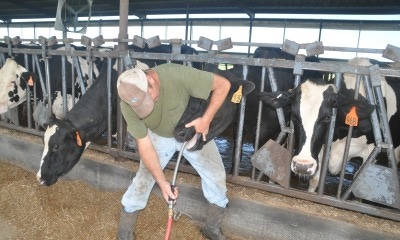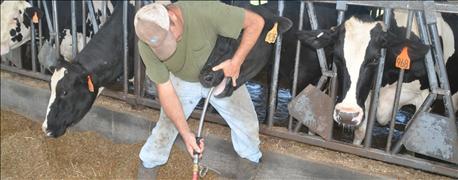
Dairy farmer Dave Lane of Colwich knew almost immediately that the cow which had just given birth to twin calves during the first week of August would bear careful watching in the days to come.
"First of all, there's the heat," he said. "Second, there's the humidity. The stress is just tremendous. And then, there's the twin calves. That so often spells problems. You put it all together and you know you need to be worried."

FEEDING: Dairy farmer Dave Lane inserts a feeding tube into a cow struggling to recover from past-partum infecteioin. Heat and high humidity put extra stress on dairy cows, making them more vulnerable to illness.
The data shows a storm of issues stressful to cattle; July had seven days above 100 degrees and seven more that topped 95 degrees. Only 6 days saw nighttime lows drop below 70 degrees. Put that in perspective with the reality that heat stress in dairy cows starts at 72 degrees.
"Dairy cows have a higher level of overall body stress than beef cattle because they are producing milk," he said. "They need to eat more and drink more. And their body processes produce more heat that they have to get rid of."
This time of year is one when things can quickly go wrong.
"Through experience I've learned that if the wheels are going to come off, it will be the last week of July or the first two weeks of August," Lane said. "The cows are ready for summer to be over. The cumulative stress is really getting to them. The greater that stress, the more easily they get sick from something else."
Dose, watch, wait
Lane gave his high-risk heifer an immediate dose of Excede, a broad-spectrum antibiotic, and kept an eye on her.
"I knew the antibiotic would probably protect her the first day or two or three, so I was really looking for signs following that," he said. "Sure enough, two days later, I saw she was struggling."
TIME TO EAT, REST: Dairy cows make their way up the ramp from milking parlor to free-staff barn at Lane Holsteins in Colwich. Sand bedding, shaded feed bunks, sprinklers and fans all help the cattle cope with heat.
The cow did not come to the feed bunk. She pulled away from her fellow cows. She kept her head down. He put her on systemic antibiotics to address the active metritis infection, but that was not enough to address the issue of non-feeding, which can quickly result in a condition called "twisted stomach."
The solution he applied to keep the cow fed and hydrated is a kind of "feeding tube" for cows -- using a tube threaded down her throat and directly into the rumen to pump a five-gallon bucket of alfalfa meal and special nutrients, an energy supplement and microbials with plenty of water -- to fill her rumen with nutrition. He fed her twice a day initially.
She was also given an IV for dextrose, B vitamins and Prevail to help lower fever and act as a pain killer.
After three days, he was beginning to see hope that this cow was turning a corner. She held her head up. She showed some interest in feed. He reduced the tube feeding to once a day.
COOLING OFF: Cows inside the free-stall barn at Lane Holsteins have the benefit of time water sprinklers and fans to help them tolerate the heat.
"It's like you are in a muddy field in a vehicle and you sort of feel traction, like you are beginning to move forward," he said. "That's kind of where she is. Not unstuck. But slowly, maybe, going forward."
During the struggle, milk production is obviously not a big concern.
"We're throwing away anything from her anyway because of the antibiotics," he explains.
Every cow matters
The life of single cow matters on a farm like Lane Holsteins, the winner of the Kansas Dairy Farm of the Year award in 2012, not just for economics, though every dime matters; but for morale in an operation where you look every cow in the eyes, three times a day and get to instinctively know when something isn't quite right.
"It's part of animal husbandry," Lane says. "You kind of learn to communicate. You sense there is just something off. Cows can tell you when something's wrong."
That's not something you learn. It's something you live.
Lane milks between 90 and 100 cows. His operation isn't a big enough dairy to have economy of scale. He can't count on a contract with a major processor to insure his profit margin. He's caught in the system of whatever the market brings.
His row crop farming operation, which grows some grain for sale and some feed for his dairy, isn't big enough to take advantage of the good years in grain prices for profits to subsidize the dairy.
He's located on the "edge of civilization," close enough to see the encroaching real estate development spreading westward from the city of Wichita. He doubts that there will be a "next generation" of Lane Holsteins.
The Kansas Department of Transportation long-range plan calls for a Wichita highway bypass that will cut his farm in half. He's lived with that for two decades and he and his wife, Dawn, have raised their four children with that in mind. He has even called it his "force me to retire plan" because it would destroy his lagoon management plan.
"They are only proposing to buy a 3 to 4 acre strip but it destroys my environmental plan," he said. "It would mean the end of my dairy."
There is no timetable for that highway expansion and the depletion of the transportation fund in recent years to fill shortfalls in the state's general fund could delay it for years.
Future impacts daily decisions
At the same time, the specter of the future of the land his farm occupies affects day to day decisions he makes for his dairy.
He's undertaken drainage and lagoon improvement projects, shaded a feed area outside the milking parlor, added feed storage facilities and a free-stall barn with fans that kick on when the temperature exceeds 70 degrees and kick off when it drops below that level. Sprinklers mounted on a rail above the feed bunk spray down feeding cows on a regular schedule.
He has built a "warm-up pen" to move cows who are close to calving into conditions that reduce stress and improve their condition prior to giving birth. He said it has prevented premature births and has helped cows have better and quicker recoveries with fewer complications.
He knows that he is a good steward of his land and a good caretaker of his cows. But he feels that his business is just barely getting by and it is hard to see a path to getting ahead.
Expansion really isn't an option, given that land sells at "development prices" in his location just south of 21st Street on 167th Street, also known as Colwich Road, in Sedgwick County. Expanding his herd would bring in more revenue -- but also incur more costs and present the sticky problem of finding qualified help to do the work. He doesn't see it improving the bottom line.
One day at a time
On a hot August day, dairy cows returning from the 11:30 a.m. milking stopped to eat, to get a wetdown and then to relax on cool sand bedding in the free-stall barn and let the fans evaporate the water from their skin.
Lane has looked into newer "ventilation tunnel" technology for free-stall barns that generate the effect of a constant 6 to 8 mph breeze. He's even thought about how to add shade in his dry-lot pasture area.
The reality check is that investing in new technologies, while they might be desirable, just don't pencil out when it comes to keeping the dairy afloat.
They might not be better just because they are newer and they just might be counter-productive down the road when the inevitable time to sell out comes.
"When I look at what's here, the structures already built, I realize that any future buyer who isn't going to continue a dairy -- and I just don't see that happening -- will see this just as stuff that has to be torn down. I realize that building any more structures reduces the resale value of the land," he said. "How can I justify spending money to build something that will be seen as a liability to resale?"
In the meantime, as his dairy cows move down the ramp from free-stall barn to milking parlor for the midday milking -- one of three every day -- he rescues a cow with a foot problem and moves her into his "ambulatory hospital" shed where he can keep a close eye on her.
He monitors the cows in the "warm-up pen," prepared to pull a calf if necessary.
He worries about wet weather and weed pressure on his brown midrib forage sorghum crop.
He continues to watch the improvement in the mother of twins.
Sometimes, he said, you just do the best you can today.
About the Author(s)
You May Also Like






